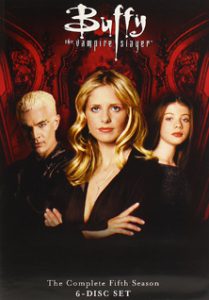It took me 11 years since its original airing, but I finally watched “The Body” for a second time as part of my rewatching of “Buffy the Vampire Slayer” Season 5 (2000-01, The WB). And, although I teared up a bit during the two Anya scenes, I made it out alive.
In my head, I had split “Buffy” episodes into two categories: “The Body” and the other 143 episodes. As writer-director Joss Whedon intended, “The Body” is a visceral, no-punches-pulled look at the death of a loved one, in this case Buffy’s mom, Joyce.
Additional pain is dealt out to fans because we’ve known Joyce for five seasons, and — after not having much to do in Season 4 — she gets more screen time this year with the addition of Dawn to the Summers family. Unlike most other episodes about death, “The Body” doesn’t fall back on spiritual escapism; it’s all about pain, confusion and the shockingly mundane.

“Buffy the Vampire Slayer” Season 5 (2000-01)
WB, 22 episodes
Creator: Joss Whedon
Stars: Sarah Michelle Gellar, Alyson Hannigan, Nicholas Brendon
However, it fits with the rest of Season 5 more than I originally thought. This is a whole season of game-changers. Dawn doesn’t exist at the start of the year; Buffy sacrifices herself to save her in the finale. Spike goes from bad guy to a member of the gang whom Buffy “treats like a man.” Riley goes from a perfect boyfriend to not being on the show at all.
I had remembered Season 5 as being more serialized than it really is, a skewed impression that comes from the final four episodes of ramped-up Buffy vs. Glory conflict. My ideal TV season is one where most episodes are standalones, allowing for thematic exploration of an issue, yet the overall plot moves forward with each installment. “Buffy’s” third season is the masterwork in this form, but Season 5 is a nice example, too.
Season 5 is a substantial step up from Season 4 and one that makes a strong case for being the series’ second-best, behind Season 3. Here are my rankings of the 22 episodes:
1. “The Body” (episode 16, written by Joss Whedon)
As is the case with many viewers, it’s a couple of Anya lines that get me reaching for the Kleenex. First is in Willow’s dorm room: “And Xander’s crying and not talking, and, and I was having fruit punch, and I thought, well, Joyce will never have any more fruit punch ever, and she’ll never have eggs, or yawn or brush her hair, not ever, and no one will explain to me why.”
Second is in the hospital waiting room: “I wish that Joyce didn’t die … because she was nice. And now we all hurt.” And Buffy says simply, “Thank you.” Emma Caulfield’s Anya, in some ways the black sheep among the main characters, pushes “The Body” to the level of masterpiece.

2. “Fool for Love” (7, Douglas Petrie)
Before this episode, which crosses over with “Angel’s” “Darla” (also a great one), Spike was merely highly entertaining. From this point forward, we sympathize with him, because we see how much he struggled with love as a human and continues to do so now that he’s a vampire. Petrie pulls off the effective trick of making us see this story from Spike’s perspective, with Buffy as the antagonist.
3. “The Gift” (22, Whedon)
The final couple of minutes rank right up there with the end of Season 2’s “Becoming, Part 2” in terms of endings piled high with tearjerker moments. Buffy’s words to Dawn, played over the shot of her jumping into the interdimensional portal in order to close it, is memorable: “The hardest thing to do in this world is live in it …”
But Spike breaking down and crying is the moment that got me on this latest viewing. It’s also worth noting that when this episode aired, well into the Internet age, I and my friends had no idea that Buffy was going to die; I was totally wrapped up in the idea of Dawn having to die to save the world. Kudos to Whedon for well-played narrative misdirection.
4. “Real Me” (2, David Fury)
It’s a role that would cause lesser shows to jump the shark: The main character, an only child for four years, suddenly has a magically created sister. Michelle Trachtenberg, herself a big “Buffy” fan, makes it work, as does Fury, who pens an amusing “girl writing in her diary” episode to kick off the arc of the forever put-upon Dawn. Also, there’s nothing like a chocolate-covered face to make a new character endearing.
5. “I Was Made to Love You” (15, Jane Espenson)
This episode is somewhat underrated because it’s overshadowed by the final scene that leads into “The Body” (“Mom? Mom? Mommy?”). But Shonda Farr is heartbreakingly good as the robot of the title who only wants to please Warren, who has since lost interest in his inevitably clingy creation. If Britney Spears had been cast as April, as was the original intent, the episode would be more well-known, but I doubt it would be better.
6. “Forever” (17, Marti Noxon)
The episode after “The Body” holds onto some of its predecessor’s residual greatness with a couple more classic moments — Spike brings flowers to the Summers home and Angel visits Buffy and they have a nice, night-long talk that illustrates the depth of their caring for each other even though they can’t be together. Noxon deftly moves the action back into the horror/fantasy realm, too, as Dawn tries to resurrect her mom from the dead.
7. “Intervention” (18, Espenson)
This episode is an eclectic, but effective, mix of moods. We get the comedy of the Buffy-bot (great performance by Sarah Michelle Gellar, by the way), who lives only to please Spike and who pronounces Giles’ name with a hard “G.” There’s also Buffy going on a spiritual journey into the desert, where the First Slayer creepily tells her that “death is her gift.” The most enduring image, though, is Spike, who takes a vicious beating from Glory rather than reveal that Buffy’s sister is the Key.
8. “Into the Woods” (10, Noxon)
Like many fans, I took a while to warm up to Riley. Even on my initial viewing, I remembered feeling bad when Riley leaves on the military chopper, as if I — like Buffy — was partly to blame for his departure. On my rewatching, I’ve liked the character more and it makes this hour even more powerful. It’s dominated by a couple of great dialogue-heavy scenes, first Buffy telling off Riley, then Xander convincing Buffy that she was wrong to send him away. Of course, this being “Buffy,” she’s too late to catch him.
9. “Spiral” (20, Steven S. DeKnight)
This must rank as one of the most expensive episodes of “Buffy,” as the Scoobies fight off Medieval soldiers seeking to kill Dawn even as they tear down the highway in an RV. I had forgotten that Giles gets skewered by a pike while driving (he’ll be OK in a couple episodes); it’s sort of a foreshadowing of a dramatic moment in “Serenity.”
10. “The Weight of the World” (21, Petrie)
As far as dream-space tales in the Buffyverse go, this one is overshadowed by Season 4’s “Restless.” However, the scenes of a young Buffy meeting her newborn sister and saying she wants to help take care of her are incredibly cute and important in setting up the season finale. Perhaps a bit more could’ve been done to show the weight Buffy felt from throughout the season; still, this is a nice breather before the gut-wrenching finale.
11. “Blood Ties” (13, DeKnight)
In an effective metaphor-driven episode, Dawn’s trauma over being a supernaturally created Key ties in nicely with the universal teen feeling of wondering how they fit into the world: “Am I real? Am I anything?” It’s a well-deserved showcase for Trachtenberg.
12. “Crush” (14, Fury)
This weirdly toned but highly entertaining hour features Spike dealing with recriminations from the women in his life: Harmony, Drusilla and Buffy. If “Fool For Love” didn’t do the trick, “Crush” should make you feel Spike’s pain and frustration with love.
13. “Family” (6, Whedon)
Although it’s one of the least remarkable entries on Whedon’s resume, “Family” is important because it brings Tara more fully into the fold of the Scooby Gang. It answers a long-gestating cliffhanger from Season 4: No, she’s not a demon. Her crazy family just wanted her to think she was a demon so they could control her.
14. “Checkpoint” (12, Petrie and Espenson)
It’s pretty cathartic, and long overdue, when Buffy finally tells off the Watchers Council and sets the terms that will allow her and Giles to fight Glory without bureaucratic oversight.
15. “Out of My Mind” (4, Rebecca Rand Kirshner)
Yes, it’s mostly a Riley episode, dealing with the ill effects of the government-implanted chip in his chest from last season. But I’ve decided I like Riley more on this viewing, and it’s cool that he gets an hour. There’s also a fascinating path not taken here, as it briefly appears that Spike will get de-chipped and resume a reign of terror on Buffy (of course, I’m glad they didn’t go that route).
16. “Buffy vs. Dracula” (1, Noxon)
I had mixed feelings about this episode when it aired, as I felt that the Buffyverse was rich enough that it didn’t need to borrow an iconic vampire from outside the franchise. Ultimately, Dracula worked for me as a “Buffy” character thanks to the spot-on performance by Rudolf Martin, coming off the same role in a Dracula TV movie (which I still haven’t seen; I wonder if the movie should be considered part of “Buffy” canon?) There’s also good humor here, such as everyone thinking it’s cool, rather than scary, when they learn ol’ Drac is in Sunnydale.
17. “The Replacement” (3, Espenson)
Ah, a long-overdue Xander episode. Although Espenson has written better, there’s fun to be had here, especially in the final-act revelation that both Xanders are Xander. It’s a nice commentary on how the character, like most of us, has dual aspects to his personality — one confident, the other not. Nicholas Brendon’s twin, Kelly Donovan, makes this episode possible (or at least more affordable) by playing one of the Xanders when both of them are on screen.
18. “No Place Like Home” (5, Petrie)
This was a pivotal episode when it aired, as we didn’t know the story behind Dawn’s sudden appearance at the end of the season premiere; there was even a possibility that she could be evil. Also, Glory is introduced; Clare Kramer will have a ball throughout the season playing a frustrated, selfish — and fashion-forward — brain-sucking God. I wouldn’t have wanted her around for more than one season, but Glorificus certainly made a worthy villain for Season 5.
19. “Triangle” (11, Espenson)
I wish it would’ve been more of an Anya-centered episode in a season that had already given us hours devoted to Xander, Riley, Tara and Spike. Instead, it’s the most unabashedly comedic episode of the season as Abraham Benrubi has a blast chewing (and smashing) scenery as Olaf the Troll.
20. “Shadow” (8, Fury)
Glory’s snake demon, like many of the more ambitious monsters on the show, doesn’t entirely ring true, but it’s still an entertaining attempt. Also, we get the first of Joyce’s hospitalizations that set the stage for “The Body.”
21. “Tough Love” (19, Kirshner)
The centerpiece of this episode is Tara getting brain-sucked by Glory. Although Amber Benson gives a good performance in her four “mindless” episodes, I can’t say I really enjoy them, simply because I miss the real Tara. Willow’s love of Tara is proven here, but I didn’t really buy that they’d be quarreling in the first place.
22. “Listening to Fear” (9, Kirshner)
Keeping with the mindless theme, a mentally unhinged Joyce is terrorized by a giant extraterrestrial cockroach in her bedroom. I’m reminded of the “X-Files” episode “Folie a Deux,” where a supposedly crazy Mulder experienced the same thing. And that episode reminded me of the “Buffy” Season 1 episode “Teacher’s Pet.” “Listening to Fear” is entertaining enough, but it’s a few degrees removed from originality, and hey, something from this great season has to rank last.
How would you rank the 22 episodes of Season 5?
Click here for an index of all of John’s “Buffy” and “Angel” reviews.

